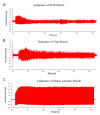Endurance of the Dorsal and Ventral Muscles in the Neck
- PMID: 33467263
- PMCID: PMC7739275
- DOI: 10.3390/jfmk5030047
Endurance of the Dorsal and Ventral Muscles in the Neck
Abstract
Endurance of the muscles of the neck are rarely studied. This study measured the endurance index (EI) of the sternocleidomastoid (SCM) and upper trapezius muscles of the neck (trap). The vastus lateralis (VL) was used for comparison. Skeletal muscle endurance of twelve healthy subjects, age 19-22 years, were tested on their SCM and trap in random order on one day, VL was tested on a separate day. Participants were tested in the supine position for the SCM and VL muscles and the prone position for the trap. Muscle contractions consisted of a 5 Hz twitch electrical stimulation for 5 min. Muscle acceleration (resultant vector) was measured using a triaxial accelerometer. EI was the ending acceleration as a percentage of the maximal acceleration. The endurance index (EI) for the SCM, trap, and VL was 42.3 ± 13.0%, 42.3 ± 20.2%, and 92.9 ± 11.0%, respectively. The EI of the VL was significantly higher than the EI of the SCM (t(2,22) = 10.33, p < 0.001) and the trap (t(2,22) = 7.625, p < 0.001). The EI was not different between the SCM and the trap muscle (t(2,22) = 0.004, p = 0.997). In conclusion, the neck muscles had much less endurance than the muscles in the leg and could make fatigued athletes more susceptible to concussions caused by head impacts.
Keywords: fatigability; human subjects; muscle fatigue; myography; neck muscles; neuromuscular electrical stimulation.
Conflict of interest statement
The authors have no conflict of interest to declare.
Figures



References
-
- Very Well health. The Anatomy of the Sternocleidomastoid Muscle. [(accessed on 3 May 2020)]; Available online: https://www.verywellhealth.com/sternocleidomastoid-muscle-anatomy-297064.
LinkOut - more resources
Full Text Sources
Medical

